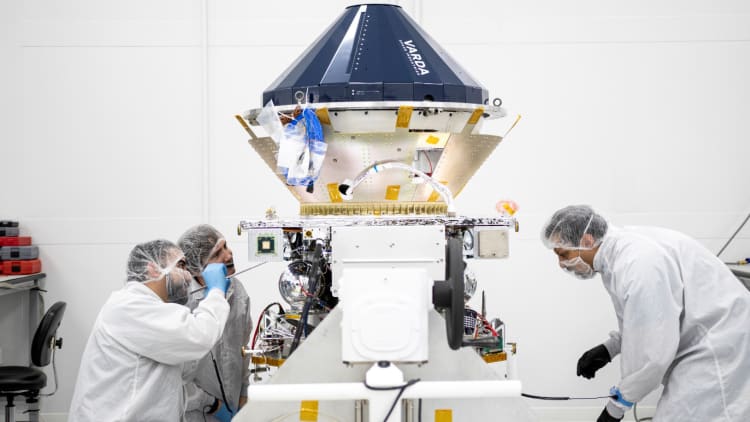An ADSEP with blue PIL-BOXs, hardware which will be delivered to Sierra Space for the LIFE habitat pathfinder mission.
Redwire
Space infrastructure company Redwire is putting a biotech technology test bed on Sierra Space’s first mission with its inflatable space habitat, establishing a new partnership between the two companies to make drugs in orbit.
“It’s an incredible moment for Redwire, an incredible moment for Sierra,” Mike Gold, Redwire’s chief growth officer, told CNBC. “We go to space not just for science and discovery, but to improve life on Earth.”
“I can’t tell you how long I’ve been waiting to say those words. This is the first step in an amazing journey to come,” he added.
Biological and pharmaceutical research and production is seen as a key customer market for microgravity platforms in space. Redwire is not alone in targeting that market, with startups like Varda and Space Forge also working on such test beds.
The idea is to manufacture drugs in space, leveraging the environment to create unique materials, that would be returned for use on Earth.
“Many drugs are based on crystals. In space you can create perfect, or at least different versions of, crystals that can then be leveraged to create new versions of drugs with greater efficacy with the ability to last longer,” Gold said.
An ADSEP facility, primarily supporting regenerative medicine research associated with Redwire’s Bio Fabrication Facility (BFF).
NASA
Redwire will include its ADvanced Space Experiment Processors (ADSEP), which process what it calls PIL-BOXs (Pharmaceutical In-space Laboratory – Bio-crystal Optimization Xperiment), when Sierra flies its LIFE (Large Integrated Flexible Environment) habitat on a demonstration mission, expected in 2026.
Redwire currently has an ADSEP on the International Space Station, which was installed in January, and expects to fly three PIL-BOXs on the upcoming SpaceX CRS-28 cargo mission. It’s previously partnered with Eli Lilly to conduct testing with PIL-BOXs, which were developed through a partnership with NASA.
Sign up here to receive weekly editions of CNBC’s Investing in Space newsletter.
“The ADSEP is like the Nintendo, and the PIL-BOX is the cartridge you put in it,” Gold said.
The pathfinder mission of a LIFE module will represent the first time it flies in space. Sierra has made steady progress in testing subscale LIFE models, including a test last week at NASA’s Marshall center in Huntsville, Alabama.
An artist’s rendering of a commercial space station in orbit.
Sierra Space
Both Sierra and Redwire are among the five companies developing the Orbital Reef space station, one of several private habitats aiming to be successors to the ISS when it’s expected to be retired at the end of this decade. Orbital Reef is envisioned as a “business park” in space, hosting astronauts for research as well as tourists for exotic excursions.
Gold said this pathfinder LIFE flight will help demonstrate the business case for the larger future station. He also noted that the strategic partnership between the companies includes a road map on revenue and intellectual property sharing that “will become more explicit as we actually go into operations.”


